#Ferdinand Barth
Text
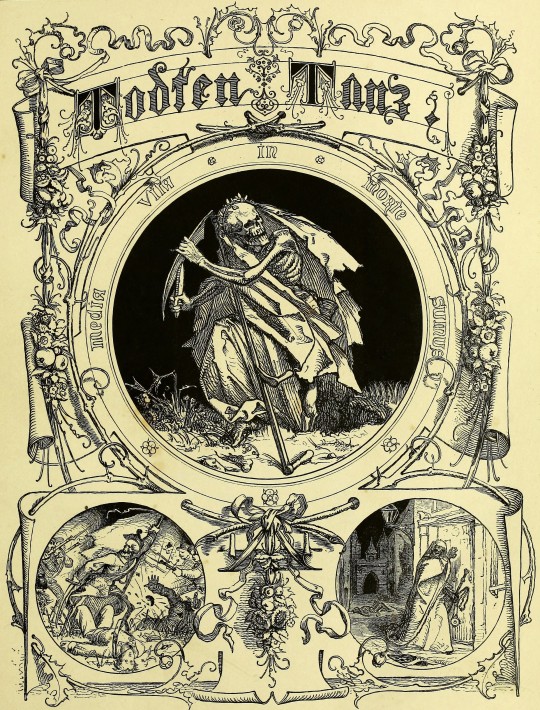
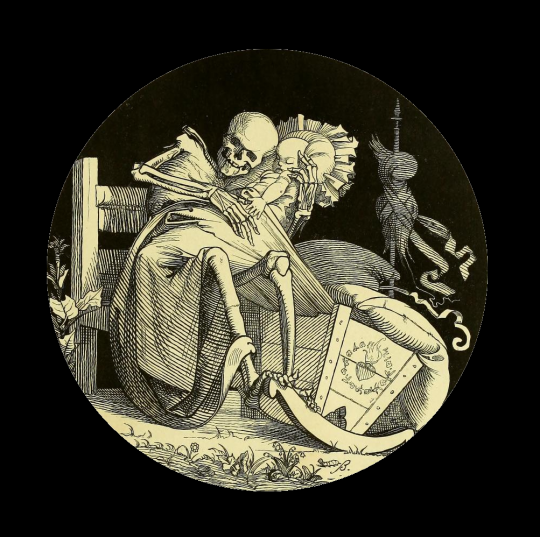
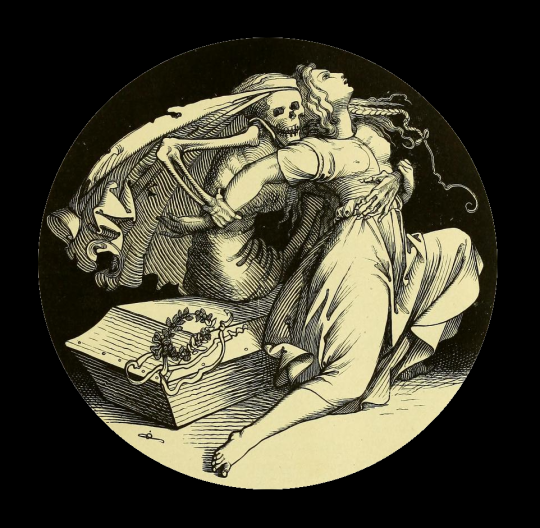

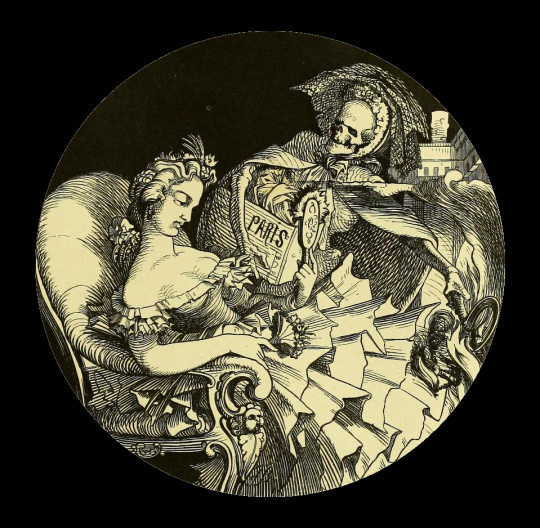
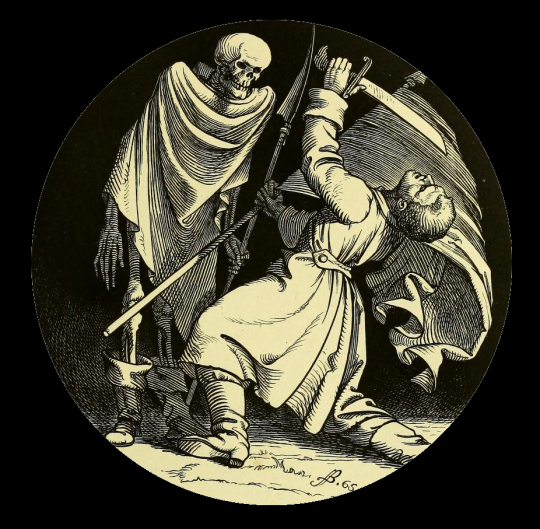
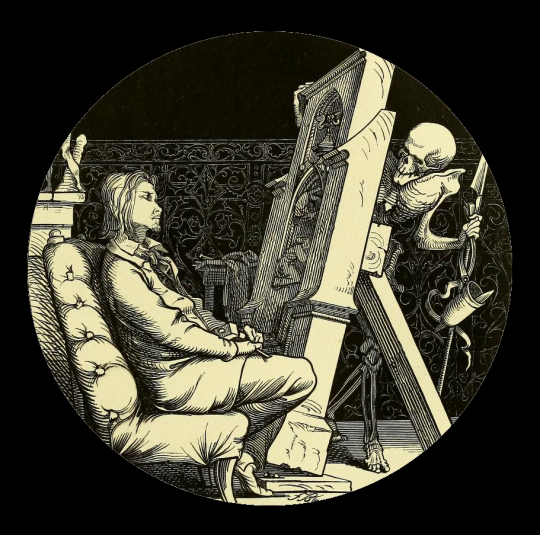
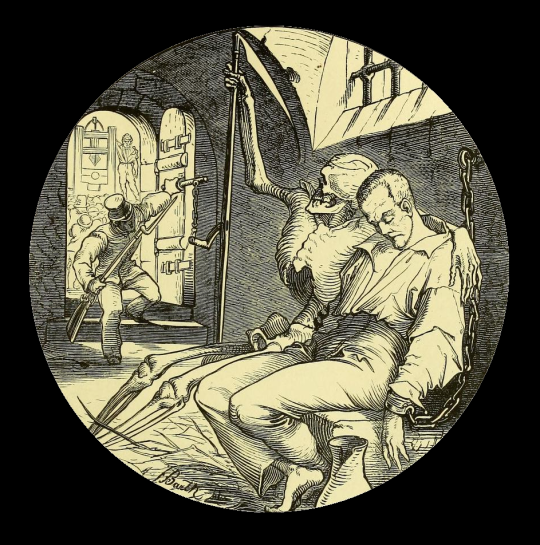
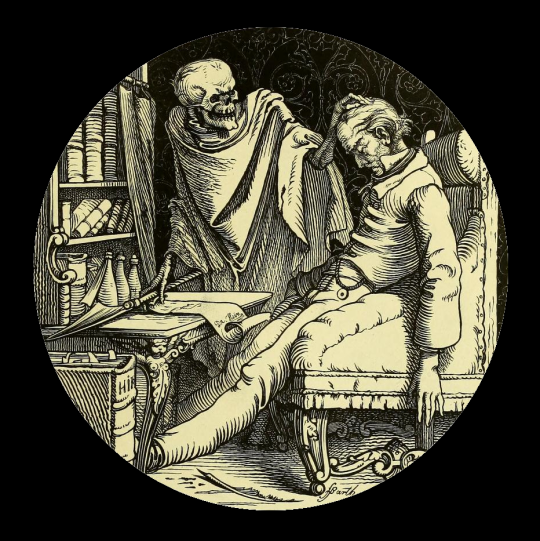

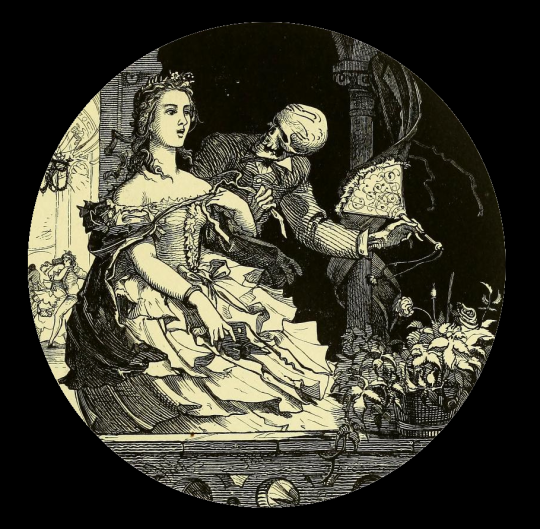

#art#etching#woodcut#engraving#art book#illustration#dance of death#macabre#dark humor#humorous#arbeit des todes#ein todtentanz#ferdinand barth#münchen deutschland#allegory#memento mori
295 notes
·
View notes
Text
Reading Notes 3: Saussure to Barthes

In “Course in General Linguistic” and “Mythologies,” Ferdinand de Saussure and Roland Barthes set the groundwork for our studies in semiotics and structuralism.
What is the arbitrary nature of the sign, how is the sign differentiated from a symbol, and why is language the most characteristic of all sign systems?
In what ways is myth a semiological system?
@theuncannyprofessoro
17 notes
·
View notes
Text
The Sorcerer's Apprentice

Illustration of Der Zauberlehrling. From: German book, "Goethe's Werke", 1882, drawing by Ferdinand Barth (Künstler)
"The Sorcerer's Apprentice" (German: "Der Zauberlehrling") is a poem by Johann Wolfgang von Goethe written in 1797. The poem is a ballad in 14 stanzas.
Story
The poem begins as an old sorcerer departs his workshop, leaving his apprentice with chores to perform. Tired of fetching water by pail, the apprentice enchants a broom to do the work for him, using magic in which he is not fully trained. The floor is soon awash with water, and the apprentice realizes that he cannot stop the broom because he does not know the magic required to do so.
The apprentice splits the broom in two with an axe, but each piece becomes a whole broom that takes up a pail and continues fetching water, now at twice the speed. At this increased pace, the entire room quickly begins to flood. When all seems lost, the old sorcerer returns and quickly breaks the spell. The poem concludes with the old sorcerer's statement that only a master should invoke powerful spirits.
5 notes
·
View notes
Text
Discussion leader presentation
AHA - Take On Me:
Take on Me by Aha is centred around the singer's interest to woo a romantic interest and persuade him to accept him as her lover. The title of the song, “Take on Me” signifies his plea for her to take a chance on him. Although his love for her is genuine, he struggles with shyness and therefore it is difficult for him to express his feelings to this particular woman. Interestingly, the lady also appears somewhat hesitant or reserved in her response to his advances, occasionally displaying shyness herself. Nevertheless, the singer is determined to win her affection while the opportunity is present. Consequently, most of the song revolves around his earnest appeal for her to embrace his love and be open to the affection he is offering.
youtube
The music video for "Take On Me" is known for its distinctive combination of live-action and pencil-sketch animation, which creates a unique visual style. It tells a story of a woman who enters a comic book world and interacts with the animated protagonist, all while blending with the real world. The video effectively blurs the lines between reality and fantasy, as the characters move between the two worlds. This creates a sense of wonder and excitement, making it a memorable visual experience.
We're talking away
I don't know what I'm to say
I'll say it anyway
Today is another day to find you
Shyin' away
Oh, I'll be comin' for your love, okay
These first lyrics capture a sense of longing, determination, and hope in the pursuit of romantic love. The singer is willing to take a chance and make an effort to win the affection of someone they are interested in, even if it means overcoming uncertainty.
Ferdinand de Saussure's "Course in General Linguistics"
Although not directly related to A-ha's "Take On Me" music video, some parallels can be drawn. The video features live-action and animation, signifying different realities. This shift in signs, akin to Saussure's theory, underscores the arbitrary relationship between signifiers and signifieds. The woman's transition from reality to the animated world signifies a deliberate change in meaning, reflecting her desire for adventure and escape. Boundaries between these realms blur, reflecting Saussure's idea of combining and blending signs to add depth to the narrative. Though Saussure's work pertains to language, its concepts can be applied to analyze the video's narrative structure and the interplay between signs and meanings, enriching the viewer's experience.
Roland Barthes' "Mythologies"
The video employs semiotics, playing with signs and symbols by juxtaposing real-world live-action and animated comic book sequences. These shifts influence how viewers interpret the narrative, reflecting the manipulation of signs and symbols akin to Barthes' concepts.
In "Mythologies," Barthes delves into the construction of myths through signification. In the video, the comic book becomes a mythological element, symbolizing an alternate reality. The use of signs and symbols in the video's narrative serves as a modern form of myth making. Furthermore, Barthes' exploration of consumer culture's role in creating myths around everyday objects finds resonance in the video. The comic book becomes a culturally significant symbol for the characters.
Peter Gabriel- Sledgehammer
youtube
Music Video: Peter Gabriel - "Sledgehammer"
"Sledgehammer" is a song by British musician Peter Gabriel, released in 1986. The music video for this song is known for its innovative use of stop-motion animation. The video was directed by Stephen R. Johnson features a variety of surreal and imaginative scenes, often involving unconventional and whimsical imagery.
Similar to A-ha's "Take On Me," the "Sledgehammer" video undergoes a striking visual transformation. In "Take On Me," the transformation occurs between live-action and comic book animation, while in "Sledgehammer," it involves stop-motion animation and claymation. Both videos use these visual shifts to create an otherworldly and fantastical atmosphere.Both videos play with the concept of narrative, taking viewers on a journey that blurs the lines between reality and imagination.
"Take On Me" features a love story that transcends the boundaries of a comic book, while "Sledgehammer" explores a surreal dream-like narrative filled with unconventional and symbolic elements.
DISCUSSION QUESTIONS:
The video features a significant transformation of the characters between two worlds. How does this theme of transformation relate to the concept of self-identity? What can we learn from the characters' experiences of changing their reality and appearance to find love and connection?
Take On Me" uses metaphors such as the transition from the comic book world to reality. Do they challenge or reinforce prevailing social norms and expectations regarding love and adventure, and how do these interpretations resonate with today's audiences?
Take On Me" is an iconic '80s song. Why do you think music from this era, including "Take On Me," continues to resonate with audiences across different age groups? How does it capture the spirit and emotions of its time while remaining timeless?
4 notes
·
View notes
Text
Discussion Leader Presentation
youtube
A-Ha released Take On Me in 1985. The band is considered to be a one-hit wonder. Take On Me is considered to be about a girl that the lead singer, Morten Harket, wanted to be with. The song is Harket’s attempt to convince the girl to give him a chance on him, to “take him on.”
The music video shows a girl going in and out of a 2-D world, symbolizing her going in and out of consideration of taking a chance on Harket.

The video we viewed is actually the second music video made for the song. The first was a simple video of the band members singing the song against a blue background. In this video, the live-action footage was traced with a frame-by-frame process called rotoscoping. It took 4 months to rotoscope the 3,000 frames in the video.
The video uses a romantic fantasy plotline. A young woman, who is played by Bunty Bailey, falls for the male lead of the video played by lead singer Morten Harket. The more time she spends with Harket, the more she wants to be with him. She becomes blinded by the enjoyment she has in the 2-D world that is obviously separate from reality.
Course In General Linguistic Ferdinand de Saussure
Through his lyrics, Harket uses de Saussure’s speech/la parole to verbally demonstrate why this girl should take a chance on him. The lyrics represent the language itself, the speech/la parole that de Saussure describes. The lyrics serve the purpose of Harket directly communicating to the girl as to why she should go out with him. Through the music video, Harket is using de Saussure’s language/la langue to visually show why the girl should take him on. According to de Saussure, langue is “the internal structure of the language, not the language itself.” The video serves as the internal structure and representation of the language itself. The lyrics themselves are the
The different realities in the video, both the 2-D world and the real world, represent two different signs. In the 2-D world, Harket is a sign for what the girl wants. In the real world, he is a sign for what she knows she can’t have. The opposite signs in each reality represent the tribulations of young love that Harket is struggling with, as proved by the lyrics of the song.
Mythologies Roland Barthes
In his essay, Mythologies, Roland Barthes defines “myth,” and how it affects how we as humans perceive and consume media. He says that myths help to convey messages and communicate. Every form of media that we consume has some sort of myth that conveys some sort of message or meaning of the media, whether it be a headline, a film, a novel, etc. In Take On Me’s music video, Harket references back to Barthes’ description of myths, in that he is displaying a false version of himself that seems more appealing in order to convince the girl to go out with him. The girl, of course, believes what she sees because she is infatuated and developing feelings for Harket. The myth in this video is Harket’s ability to bring the girl into this imaginary world, and the girl consumes and believes that myth because of her feelings for Harket, and her desire to be with him.
youtube
Harry Styles released Satellite in May 2022 as part of his third album Harry’s House. The highly anticipated album went on to win Album of the Year at The Grammys. The song seems to be about wanting someone that you cannot have. However, Harry Styles fans have also compared the song to what it feels like to be “the therapist friend,” and wanting to be there for someone important in your life.
The video follows a robot trying to find a satellite that he saw on the news while backstage at a Harry Styles concert.
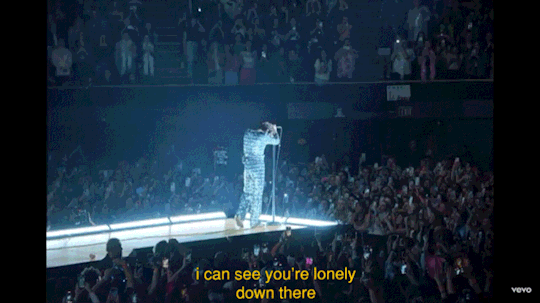
The video features footage of Harry and his band backstage and on stage before showing the robot, named Stomper, through California as it searches for the satellite. When it finally finds the robot after realizing it is in the sky, Stomper lays in a field next to Harry and slowly, his battery dies as they both look up at the sky.
The song seems to be about wanting someone that you cannot have. However, Harry Styles fans have also compared the song to what it feels like to be “the therapist friend,” and wanting to be there for someone important in your life. The video plays into the first idea by showing Stomper going in circles (like a satellite) while trying to find the satellite. Styles writes “Spinning out, waitin for ya to pull me in // I can see you’re lonely down there // Don’t you know that I am right here.” Styles clearly wrote these lyrics for someone to hear, likely someone he wanted to be close to but could not, whatever the reason may have been.
Course In General Linguistic Ferdinand de Saussure
The langue, or the unspoken language in this music video, is Stomper’s dedication to finding the satellite that he saw. Both Stomper’s dedication represent the speech/la parole, and the lyrics that Styles wrote are the speech because they are Styles’ direct translation of his feelings of wanting to be there for someone that he cannot have. Music videos are generally an additional form of media that provide a langue for the artists’ original speech. In both Satellite and Take On Me, the visual aspect allows the artist(s) to add on to the original speech/la parole that they had written by providing a representation of “the internal structure of a language, not the language itself,” as de Saussure described.
Mythologies Roland Barthes
In the video, Stomper ventures to find the satellite after seeing it on the TV backstage at one of Harry Styles’ concerts. There seems to be a hint of romantic interest behind Stomper and the satellite, which can be compared to Disney’s 2008 film, Wall-E.


The upbeat pace of the song, as well as the music video following Stomper on his search for his satellite, seem to serve as a “myth” that Stomper and his satellite will have a happy ending. Upon initial viewing, viewers might be awaiting Stomper finding his satellite because of the myths and signs providing false hope for a happy ending. Unfortunately, when Stomper realizes his satellite is in the sky and he cannot get to it, he sits in a field next to Harry Styles and looks up at the sky, before realizing that his battery is running low. He accepts it and looks back towards the sky, towards the satellite that he was dedicated to finding. He spends what he knows will be his last moments as close to his satellite as possible, knowing he will never be able to have what he so badly wanted.
Discussion Questions
The upbeat tune of Satellite gives the myth that the plot of the music video will have a happy ending. In what ways do song lyrics or beats provide false signs about the true meaning of the song (i.e. a sad song that sounds happy)?
Satellite and Take On Me have similar themes of wanting something you cannot have. Harry Styles’ hit song, As It Was, has been compared to Take On Me for having a similar sound. Besides theme and sound, how can songs be related to one another?
Take On Me and Satellite also have similar auras of being written to someone that the respective artists want to be close to. However, the aura of Take On Me may be overlooked as it is such a popular and catchy tune that listeners may sing along without digesting the lyrics. Similarly, it is unclear if Satellite was written for a friendship or relationship, or even a familial relationship. However, fans have interpreted the lyrics through many different lenses. In what ways can the auras of a song change?
4 notes
·
View notes
Text
Blog - Semiotics
Semiotics, the study of signs, originated with structuralism, founded by Ferdinand de Saussure. According to Fiske (1990, pp.115), "Structuralism's enterprise is to discover how people make sense of the world, not what the world is." This involves understanding how individuals utilize their culture and senses, such as sound, touch, or sight, to communicate effectively in the world.

Semiotics permeate our daily lives and are particularly evident in the media. By studying this field, I can grasp how companies employ semiotics to communicate with their audience. This knowledge can then be applied to my own work, allowing me to convey deeper meaning and effectively communicate with my own audience.
Ferdinand de Saussure laid the groundwork for semiotics by introducing Sign, Signifier, and Signified. The Signifier, representing the sound or word, and the Signified, representing the image or concept, combine to form the sign we understand. However, these words are arbitrary and gain meaning only in relation to language, where a different signified can be created by the same signifier. The system becomes intricate as cultures and social structures influence these signs deeply.
Charles Sanders Peirce expanded on this system by identifying three key types of signs: Symbolic, Indexical, and Iconic. Roland Barthes then developed it more to uncover hidden meanings, introducing additional Signifiers and Signified called Denotation and Connotation. According to Fiske (1990), "denotation is what is photographed, connotation is how it is photographed." In simple terms, denotation represents the literal meaning, while connotation conveys the implicit meaning.
For this blog, I will analyse Riot's Splash screen art featuring "Kindred," a champion from League Of Legends (2009). The image depicts a lamb wearing a wolf mask leaning over a body with a hand on its chest, accompanied by a wolf ghost creature in a dimly lit scene.
In denotation, the lamb appears soft and sweet with its more rounded shape and slender body, while the wolf ghost looks more monstrous with is sharp fur and jagged lines. The light from the body suggests it may be dead, and the water's stillness reinforces this. Moving to connotation, I interpret the lamb's posture as indicating involvement in the man's death or expressing concern for him, due to a wound. The wolf wrapping around the lamb implies a protective role, suggesting they may collaborate. The illuminated hole in the body aligns with the idea of the man being deceased, supported by the still water indicating no movement.
Reflecting on Charles Sanders' adaptation, I noticed a symbolic theme of White and Black, often linked to life and death. The opposing colours of black and white is portrayed throughout the character's design, suggesting the usage of colours create the symbol of life and death enforcing their role within the world. This aligns with the denotation, where the character looms over a dead body, reinforcing this interpretation. Additionally, there is an iconic connection to the well-known fable of the wolf and lamb, where the wolf seeks a reason to kill the lamb. This contradicts the idea of the characters working together but further aligns with the idea of being rivals in nature.
In summary, these elements collectively depict the character as a representation of life and death working together, akin to grim reaper. Whilst they may share different point of views, they both seek the same outcome.
Understanding how developers such as League Of Legends (2009) create their characters without providing context can allow me to convey emotion and messages to my audience without having to provide text to read. From this breakdown of their work “Kindred” I understand that the use of shapes, colours, lighting and even poses all help tell a story/message. This enables me to change my old concepts to provide better shape language for the viewer to understand its personality more. And the use of creating scenes can help build a better story around my models to help convey a certain emotion.
References
FISKE, J. (1990). Introduction to communication studies. London: Routledge, pp.86
FISKE, J. (1990). Introduction to communication studies. London: Routledge, pp.115
RIOT GAMES. (2009) League Of Legends. [GAME] PC. Los Angeles: Riot Games
0 notes
Text
Barbieland as a Hyperreality

Introduction
To this essay:
For this analysis, I will be addressing how the theorists Stuart Hall, Louis Althusser, Roland Barthes, and Jean Baudrillard would discuss semiology (the connection between a signifier and signified) and the motivations behind the construction of signs. The first section will discuss the similarities and agreements of the theorists, particularly the idea that signs can have hidden motivations that are a departure from reality. The following section will further analyze this similarity to discover the differences of opinions in the theorists in the degree to which signs are a departure from reality, and the power dynamics or ultimate reasoning behind the motivation of signs. The theorist that provides the biggest departure from the others (and who also provides an ordered system to explain the differences) is Jean Baudrillard, who’s order of simulacra will be used to view where the other theorists stand on the connection between signs and reality.
The final section will analyze a scene from Barbie that contributes to the larger context of establishing Barbieland as a mirrored reality (a hyperreality) of the real world, yet the distinction and power dynamic between Barbie land and the real world and how these things ultimately lead to the finale of the movie will be analyzed through the lens of the theorists.
A conclusion regarding the film analysis and how the concepts that the theorists agreed on and disagreed on were used to analyze the film will be provided at the end.
To the theorists:
Throughout this analysis, the four writings I will be referring to are:
Stuart Hall’s “Encoding, Decoding” which discusses the linked process of how messages are produced by encoder-producers and then disseminated by decoder-receiver. This includes the misunderstandings at the connotative level, where due to situational ideologies, an encoded message will take on a multitude of interpreted readings beyond just that of the dominant or preferred meanings (those which have become institutionalized). These other readings include the negotiated code (when a decoder grants a level of legitimacy to the hegemonic definitions but adds on their own understanding at a more restricted situational level) and the oppositional code (when the decoder intends to interpret in a way opposed to the hegemonic position).
Louis Althusser’s “Ideology and Ideological State Apparatuses” evolves the classical Marxist term of the state apparatus that means the specialized apparatus that executes, and the supplementary repressive force needed to maintain this government power. Althusser’s additions to this definition include the distinguishing of the classical terms state power (the seizure or maintenance of power), state apparatus (the tools employed for state power), and the state (whose acceptance as a legitimate authority is both a tool within the apparatus and a function of state power). Althusser also cements the ideological state apparatus (ISA) which differs itself from the classical definition in that repressive force is not employed but rather certain specialized institutions that pump out beliefs that make the general masses more accepting of the state and their ownership of state power. Althusser defines the beliefs taught by ISAs as the Marxist defined ideology: a system of dominating (in mind and culture) ideas and representations. Ideology itself has no history but instead serves a social situational purpose. In the current and persisting age of capitalism, ideology can be used to distract or to persuade.
Roland Barthes’ “Mythologies” is the spiritual predecessor of Ferdinand de Saussure’s “Course in General Linguistics”, as Barthes extends the idea of the linguistic sign (the signifier, the signified, and combined product the sign). Barthes introduces a mythical system where the signified of the linguistic system (which Barthes terms the meaning) becomes the signifier of the mythical (termed the form). The final term of the myth system is called the concept. The third (correlative) term for the language plane remains the sign, but for the myth, Barthes calls it the signification. Barthes’ discusses how myths have come to dominate our understanding and point us to action through imposed meaning or social usages that have been proliferated to the point of seeming natural, logical, or inherent. Throughout the writing, Barthes exemplifies several myths such as a universal human nature/origin that blurs the importance of history and additionally promotes the eternality of human establishments such as capitalism.
Jean Baudrillard’s “Simulacra and Simulations” analyzes the relation that signs have to reality, providing a challenge to Marxism and structuralism that put an emphasis on signs obscuring or perverting the real. Baudrillard concludes that the role that signs have played in our society have evolved in successive phases of the image that marks a transition to favoring and replacing the real with simulacra that claims to represent the real but has blurred the line between real and non-real (in a state called hyperreality) to the point where the real has been replaced by simulation and emptied of depth. It is the hyperreal, the simulation’s insistence on deriving its and the real’s legitimacy through the reproduction of itself and subsequent blending of the real and fake (such as in Baudrillard’s example of Disneyland) that obstructs the first three order of simulacra and leaves a system (of symbols) deprived of depth and removed from reality, of which there is none.
Section 1: Stepping Away from Reality with Reason
To set up my later analysis around the Barbie movie, its important to establish the similarities between the four theorists I have chosen to focus on (Louis Althusser, Stuart Hall, Roland Barthes, and Jean Baudrillard). These similarities are a belief in the existence of signs, an arbitrary nature to those signs, and the need for discourse to discuss the signs of more arbitrary nature. Some of the theorists additionally agree on the role of people in power in distributing and dictating the message of the signs.
Despite these four theorists having focused on different aspects, there is a general agreement in the existence of signs if not in name in practice as something outside of reality that people have come to understand. Althusser does not explicitly talk about signs, save for one brief mention of the “sign of the cross” in reference to the material rituals/practices of Ideological state apparatuses[1]. This one reference is enough to connect signs to the ideological state apparatuses. If ISAs are meant to make the general public more open to the ruling class (allowing this class to maintain state power), than the weapon of choice of ISAs are signs that operate on the mythological plane that Barthes conceptualizes. The sign of the cross is encoded/produced by those in power, propagated/spread through ISAs such as the church or the school, used via the public, and then consumed when the public uses their own understanding to decode it and then apply what is decoded back to their own understanding. This is the process detailed by Stuart Hall, and when he mentions the “institutional structures of broadcasting” and “networks of production”[2], Althusser would come to understand those terms as euphemism for the ideological state apparatus. Barthes details the motivation behind myths, as ones that are profitable. Specifically, he talks about the “great unity of man” or how certain attributes have been accredited to nature, such putting working equivalent to the life events of being born and dying. This myth is profitable in the literal way, but it is also profitable to the people in power. The economy and the job market are also parts of the state apparatus. Barthes additionally writes that Adamisms purpose is to “give to the immobility of the world the alibi of wisdom”[3]. Who benefits from immobility? Althusser, as a Marxist, would surely say the ruling class. Hall agrees that while audiences do decode the message and apply their own understandings to them, these understandings are heavily influenced by a dominant cultural order and that misunderstandings between encoder and decoder are mediated by society (read as ISAs)[4]. These three theorists seem to, if not explicitly, agree on the existence of signs and that there are producers and benefiters within this system.
Baudrillard’s work differs heavily when coming to understand the state apparatus or rather the power/force behind the creation of signs (which I will discuss in section 2), but he does accept the existence of signs especially on the mythological plane and in fact hinges his argument on the overpopulation of them.
All of the theorists accept that certain signs, the ones on the mythological plane especially, have an arbitrary nature to them that means that the linkage between the signifier and the signified does not occur naturally. Once more, Althhusser does not specifically address signs, but he does address ideology which he defines as the “representation of the imaginary relationship of individuals to their real conditions of existence”[5]. Signs are a relationship between real conditions (a form) and a signified meaning or the concept. Althusser emphasizes that ideology doesn’t have a history, meaning that it is arbitrary and is not natural. Barthes lamentations are similar though paradoxically he says that the concept of myth do have history or rather they are intended to absorb/assume a history (as with the myth of the great unity of man); “Unlike the form, the concept is in no way abstract: it is filled with situation. Through the concept, it is a whole new history which is implanted in the myth… What is invested in the concept is less reality than a certain knowledge of reality… made of yielding, shapeless associations.”[6] Hall states that all signs and interpretations have a complex set of codes and conventions behind them, despite human tendency to believe that signs (visual and verbal) are rather than represent. He says that the “iconic signs” that are vulnerable to being read as natural since it is “less arbitrary than the linguistic[7] sign” or codes that have become “naturalized” through wide distribution[8]. When Hall mentions the linguistic sign, it is referencing that discourse (a verbal or written language) is needed to create these signs by mediating a supposed relationship between the reality and concept through language[9]. Each of the theorists directly or indirectly assume the important of discourse and discursive knowledge.
Again, Baudrillard provides a challenge as to write about his similarities requires acknowledgement of his differences, which will occur in the following section. In the effort of succinctly mentioning similarities, I believe that Baudrillard’s conception of signs as completely removed from reality is the totalization of the arbitrary nature of signs and the reliance on discourse for sign production as further proof of this since discourse provides an actual other step that further separates reality from the sign.
[1] Louis Althusser, "Ideology and Ideological State Apparatuses", in The Anthropology of the State, ed. Sharma and Gupta (Malden: Blackwell Publishing, 2006), 103.
[2] Stuart Hall, “Encoding, Decoding”, in The Cultural Studies Reader, ed. Simon During (London: Routledge, 1993), 509, 510.
[3] Roland Barthes, “Mythologies”, in Mythologies, trans. Anette Lavers (New York: The Noonday Press, 1972), 102.
[4] Hall, "Encoding Decoding", 513.
[5] Althusser, 100.
[6] Barthes, 117 - 118.
[7] I believe Hall uses linguistic here as signs that exist only within discourse thus resembling Barthes’ mythological plane over Barthes’ linguistic (verbal/language) plane.
[8] Hall, 512.
[9] Hall, 511.
Section 2: What is reality? Who dictates perceived reality?
Baudrillard provides the starkest point of difference, but through looking at his differences and his order of simulacra, we can also infer differences between the other theorists on the existence of reality and how much signs differ from said reality.
Baudrillard’s major difference is his belief in the emptiness of reality. He agrees that signs do exist (and are actually in abundance) as a representation or exchange of reality, but instead of differing on the degree of the existence of reality like the other theorists, Baudrillard says that the system (reality) that signs originally drew from has become empty. None of his fellow theorists go this far. Instead, they each fall somewhere in Baudrillard’s Order of Simulacra. Baudrillard is on the fourth order, as images to him “bear no relation to any reality whatever: it is its own pure simulacrum”. This fourth order trumps the others through the destruction of the reality the other phases believe exists[1]. The first phase is the belief that the image is a “reflection of a basic reality”. The second is the “mask[ing] and pervert[ing] of a basic reality” while the third is the masking of an “absence of a basic reality”[2]. The other theorists assume multiple of these orders or fail to conclusively deny a level.
Hall struggles to take a definitive view on the first phase, with his argument that certain signs can be closer to reality or at least “less arbitrary” than others. This suggests that there is a reality (he also explicitly says “reality exists outside of language”[3]), but his conception of encoding-decoding and the role of people in the creation of codes suggest that Hall sees images more on the second phase. He may argue with the terms masking and perverting as they seem to strongly emphasize the role of the producer over the decoder. Perversion and masking, however, gel well with the idea that there is some reality, perhaps an oppositional code or a local or class interest, that is pushed aside by the dominant hegemonic position promoted by the culture and the producers[4]. Hall may be convinced of the third order, if this reality or oppositional code is nonexistent, and the hegemonic position was created to distract from that. Yet, Baudrillard would argue that Hall’s suggestion that the degree to which something is less arbitrary is indistinguishable due to signs need to be articulated[5](and thus something can easily be articulated as “the real”) is support for Baudrillard’s argument that the inability to distinguish simulation from reality proves the lack of the latter.
Barthes laments about myths removal and displacement of history, in an argument that somewhat resembles what Baudrillard believes images and simulation do to reality. To Barthes there is no eternal myth[6] and even no nature[7]. Through this, Barthes understanding aligns somewhat with the third phase. There is one catch, and it’s through Barthes’ strong connection to another author, Ferdinand de Saussure. Barthes’ argument about the creation of myth is largely an extension of Saussure’s work, and Saussure claims that there is an existence of a reality parallel to language and that for signifiers that involve a “psychological imprint”[8] there is a very strong connection to the real. Saussure designates the symbol, as a more real sign since it relates to a visual of the real[9]. Barthes never negates Saussure’s claims, suggesting an agreement. Barthes work, through Baudrillard’s eyes, then suggests the parallel existence of a real but also a removal of the real from myths, preventing Barthes from seeing the fourth order of simulacra.
Althusser can be understood through the second or third lens, like Hall. Althusser’s focus on the power dynamics of signs leads him to neglect discussion of whether there is a reality. Yet, his Marxist alignment suggests he believes in the ability of class struggle to bring about a new set of ideologies or ISAs that better serve the working class currently subjected to the ideologies. Whether or not the ideologies of the working class have been created and proliferated (through different mechanisms than the ruling class) determines whether Althusser’s theory would realize the second or third phase of the image.
It is through Baudrillard’s insistence on the absence of real that we fall on another implied but major difference. In Baudrillard’s world, events like Watergate are publicized to (like Disneyland) make something else seem real. By promoting Watergate as a scandal, its opposite, some supposed moral order, is promoted. In a sense, Baudrillard’s work does not negate the power of the state or ISAs in promoting views. Instead, he suggests, that the public is more willing to subscribe to these ideologies than his other theorists are willing to say (especially someone like Althusser). Baudrillard talks about the “panic of production” or the desire to impose moral structure on a structureless world. There may be politicization in who has state power and the ability to produce views, but people are more willing to subscribe to ideology than live in a world without and may even derive comfort from this as proven by our fascination and love of simulation. Meanwhile the other theorists are more politicized in their claims of symbols being weaponized for the purpose of state power.
The theorists’ agreement on signs as a step removed from reality, but differing opinions on reality and the motivation behind obscuring it will come in handy for the analysis of Barbie where the real is represented by the real world and Barbie land is a manifestation of a simulation or symbolic world that derives from the real.
[1] Jean Baudrillard, “from ‘Simulacra and Simulations”, in Modernism/Postmodernism, ed. and with Introduction by Mark Poster (New York: Routledge, 2014), 162.
[2] Baudrillard, 152, 153.
[3] Hall, "Encoding Decoding", 511
[4] Hall, 513.
[5] Hall, 511.
[6] Barthes, "Myth Today", 108.
[7] Barthes, "Mythologies", 100, 101
[8] Ferdinand de Saussure, “The Object of Linguistics”, in Course in General Linguistics, ed. Bally and Sechehaye (New York Toronto London: McGraw-Hill Book Company), 66.
[9] Saussure, 68.
Section 3: From Barbieland to the Real World

The scene I will be analyzing starts around the 26-minute mark and follows Barbie’s and Ken’s journey into the real world which starts with a car ride down the pink brick road with a sign pointing the direction to the “real world” and a rainbow with “Barbie land” underneath in the other direction. Their journey includes several other sequences of bright colored transportation that mixes 2d and 3d elements until they land in the real world where the last few cutouts from the skiing sequence remain in the Venice beach boardwalk. All the travelling sequences are also brightly colored and provide a heightened sense of reality versus the duller real world. Barbie instantly feels self-conscious (around the 27-minute mark), and the two of them are abruptly faced with the differences in the real world and Barbie land (particularly in how they treat women). The travel sequence and the heightened color palette and costuming of Barbie land establishes it as the hyperreality, or the world whose symbols are taken from the real world. Thus, all the sets (the empty cups, open but impractical houses, and the beach wave that Ken crashes into) in Barbie land are emulating the real world.
Baudrillard provides the most formfitting analysis, as one could replace his Disneyland example with Barbie land. Barbie land is the colorful fun perfect symbolic taking of everything of the real world which carries none of its real depth. Even when Ken tries to take the patriarchy from the real world, he only takes with him symbols (horses, cars, and etc). The continuing interaction of the two worlds with each trying to take from or influence the other damages the barrier between the two the point where real ceases to have any depth itself with an audience who prefers simulation over reality. Afterall the executives themselves (real world versions of Ken) don’t know whether Barbie land is an alternate reality or an imaginative world. It’s also hard to determine which world influences which, as surely the execs have a role in determining what exists in Barbie land (like with Gloria’s illustration affecting Stereotypical Barbie), yet Ken’s actions affect the real world (with the selling of the Mojo Dojo Casa Houses). Then again, Ken’s actions come from the real world’s influence.
Additionally, we could think about Baudrillard’s reasoning behind the motivation of signs. Panicked production suggests we attach ourselves to this idea of Barbie and female empowerment (or even the patriarchy as shown in both worlds) as actual things because we are so afraid of a world without any order.
This removes the influence of the ruling class, which could be represented by Mattel. Althusser and Barthes may argue that there is a more sinister reason for the existence of Barbie land. That by creating a fake world that symbolically has everything the real world does not, it is a way of placating the public (particularly female) into believing that their being given power to prevent them from making attempts to seize state power. Gloria seems to be somewhat content to live or rely on the Barbie world to ease her issues with the real world. Though, in the beginning, this doesn’t seem to be working very well and her ideas (Barbie land) are actively being corrupted by the complexity of the real world, something that Baudrillard would chalk up to the absence of reality or authority while Althusser, Barthes, and to some extent Hall may assign to some larger dynamic (and misalignment) between Gloria and the ruling class which dictates the real world.
Barthes would also investigate the myth of Barbie and how it connects to the feminine ideal and capitalism. At some point in the history of Barbie, there came to be a prevalent ideology around her as representing the feminine ideal and while this may not have been Ruth Handler’s founding idea, it was co-opted by society and the ruling class (a patriarchy). Hall would be interested in this misalignment as the dominant hegemonic position has changed over time (particularly in my lifetime where Barbies of color and of differing weights and careers started appearing). There is a large difference behind what little girls (I say little girls because of the focus of the movie) versus adult men and women think of when they see Barbie. During the travel sequences to the real world and right before, Barbie is the leader and Ken is just tagging along. This is very much what a little girl would think of with Barbie. When they enter the real world, Barbie is immediately subjected to the thoughts of the adults which are lewder and more critical. She because of sexualized symbol. Hall, Barthes, and Althusser could then discuss what the motivation behind these different interpretations are and whether ISAs or some form of power is promoting the sexualized signs over the girl power ones. Sasha is an interesting character for Hall as she provides an oppositional code that stands entirely against this sexual understanding of Barbie, but in the process dismisses the original girlhood interpretation of Barbie. Sasha’s character suggests that it is some point in growing up that we adopt a different set of cultural values and a different position.

In terms of the existence of ISAs and ruling class in the movie, both the examples in the real world and the hyperreality of Barbie land seem to flounder. Let’s look at the way to easy adoption of patriarchy into Barbie land. Althusser knows that state power is achieved through ideology as well as repressive force. Yet Barbie land has no ISAs that would’ve promoted patriarchy, and it’s not suggested that the Kens used force to achieve power. It may be suggested that the Barbie’s trust in the Kens and their friendship provided ISA like structures, but this discredits that the Barbies already did seem to have established state power with their own apparatuses that they likely would not have given up. Brainwashing is a good go to excuse, and the idea that giving voice to a cognitive dissonance solves everything is this simulation world agrees with the theorists view of myth and symbols only existing through discursive action.
There is also a lot to critique about Mattel and the portrayal of the executives in the movie. They are in a sense the ruling class, as they control the simulated world of ideology that is then propagated to the public. They are a state apparatus in line with promoting the ideology of the ruling class, only shifting their views slightly if profitable. This is seen near the end of the movie where Will Ferrell’s character approves of Ordinary Barbie because the idea would make money. Yet, it can’t be ignored how these executives are very much the opposite of the ideas they promote and benefit from the immobilization of a society that embraces patriarchy. The movie never commits to the framing of the executives as a ruling class or as producers of Barbie land, perhaps because of the growing inability to distinguish the two.Mattel through set design, seems to be some kind of bridge between the two worlds with a stark office that leads into a very colorful room reminiscent of Barbie Land. It is itself a hyperreality: a place where the lines are blurred between the real world and Barbie land. This is confusing to interpretations as Mattel as the ruling class. Baudrillard would de-emphasize the importance of the ruling class and more so emphasize how Mattel and Gloria both seem to be more willing to engage in the simulation of Barbie land than the real world (notice how Barbie land is fixed but the real world is not).


Due to the continuous blurring of the two worlds, the movies focus on the simulated world of Barbie, and the real people’s fascination with Barbie land, I believe the theorists would be critical of Barbie’s choice to join the real world. In Baudrillard’s view, it makes no sense for Barbie to pursue some kind of authenticity in the real world. She lives in simulation and everyone in the real world tries their best to as well. The film leaves too much ambiguity of what is real and lacks explaining in the motivation behind the differences of the two worlds. The message of girl empowerment feels lost when Barbie land (the ideological fake world) is fixed through giving voice to cognitive dissonance, but the immobility of the real world remains because discursive action is only one layer against a state apparatus which has additional repressive forces. There is a lot of irony about how the movie only briefly criticizes the Mattel execs and the capitalistic tendencies of Barbie with how much money this movie made Mattel furthering capitalism and our desire for simulation (such as this movie). This movie finds itself having issues establishing what is real, much like the array of theorists who establish the idea of symbols but can’t quite shake the role that the ruling class has on controlling the symbol of Barbie and its role in our lives.
Conclusion
Through analyzing the four theorists and thinking about the idea of reality and how signs are related to it, I was able to analyze the relation between Barbie land and the real world in Barbie and found several interpretative issues around the motivation behind the existence of the symbols within Barbie land (assuming they were created by the producers in Mattel), the line between real and simulation, and why we should want the real if it is so hard to distinguish from simulation.
0 notes
Text
Blog Post 5 - A Semiotic Analysis of The Mario Characters
Semiotics is the study of signs and symbols and the way we interpret them. There are many theorists involved with semiotic theories, but I will be looking at Ferdinand de Saussure, the founder of linguistics and semiotics, Charles Sanders Peirce, and Roland Barthes to analyse the way characters are portrayed in the Nintendo game New Super Mario Bros (2006).
Ferdinand de Saussure’s Semiotic Theory
New Super Mario Bros (2006) was my favourite Nintendo DS game growing up, I always felt very connected to the characters and the game’s use of colour throughout each level. Saussure’s theory suggests that language is made from different signs, through the use of a signifier and a signified. The signifier is the physical form of the sign, and the signified is the mental concept of what the sign represents. Applying Saussure’s theory to New Super Mario Bros (2006), we can see how the design choices of each character are actually used to represent their character roles.
Mario wears bold colours, his red cap and his blue overalls making him stand out next to all other characters. The colour red has implications of bravery and power, while the blue overalls make him easily identified as a regular working man that appeals to the players. The key feature that sets him aside from the other characters however is his iconic moustache. The moustache implies maturity or age, creating a symbolic representation that he is experienced and likely more capable at achieving goals.
Princess Peach is used to signify royalty. The symbolism use of her softer pink colour palette implies femininity and kindness, which are traits people would often connect to a princess. Similarly, the symbolism of her crown and large dress are seen as traditional clothing items for a royal family member, the crown especially being used as a symbol of authority. Peach is often a damsel in distress character, so the use of her gentle colour palette also plays into this idea because femininity is often perceived as weaker.
Bowser is the clear villain of the story. His character design uses his size to imply his strength, making him much larger with more muscles than any other character. Additionally, the use of spikes and fire breath are clear signs of danger, alongside the use of dark shades of green and red to create an overall intimidating feeling.
Roland Barthes’ Semiotic Theory
Barthes semiotic theory looks at uncovering hidden meanings using the ideas of a denotation, connotation and myth. The denotation is the literal meaning of the sign, whereas the connotation uses the deeper associations connected to the sign. The myth combines the meanings from both the denotation and the connotation and shows the ideological meanings of the sign.
The denotation of Mario is his physical appearance. His clothing shows his regular job as a plumber, which is consistent through every variation of his character design in the games. The connotation is the heroic symbolism, even though he looks like a regular guy, he’s more than just a plumber. The myth is shown through a few aspects of the gameplay. Mario’s narrative follows the classic hero’s journey, which is an idea shown in many different games, while also incorporating the use of the damsel in distress through Princess Peach, which reinforces the heroic symbolism along with traditional gender roles.
Charles Sanders Peirce’s Semiotic Theory
Charles Sanders Peirce introduced the idea of symbolism consisting of three key typologies: the symbolic, the iconic, and the indexical. The symbolic shows that the signifier is arbitrary and conventional, and the iconic is an imitation of the signified. The indexical has a direct link to the signifier, almost like a secondary action. In relation to the characters in New Super Mario Bros (2006), Bowser is the symbolic, Mario is the iconic, and Princess Peach is the indexical.
Bowser symbolises danger and evil, making him the antagonist. His appearance is completely symbolic to represent danger, his spiked shell and dragon/dinosaur appearance aren’t connected to reality but are recognised as unsafe and menacing. Bowser himself is used symbolically throughout the game, with his face appearing throughout to show he is the main cause of the obstacles Mario faces.
Mario is the iconic symbol of the story. When you think of the games, you immediately think of Mario and his distinctive appearance. Every aspect of his appearance works together to create the iconic design, while still resembling a regular person. He is immediately identifiable in any environment or scene because of his iconic appearance.
Princess Peach is directly connected to Mario. Since she is represented as the damsel in distress character, she can’t exist without Mario. The fact that she is taken by Bowser in every game is important to continuing the narrative, which in turn makes Bowser the main conflict or obstacle in the game.
Each main character in the New Super Mario Bros(2006) game uses semiotics effectively to create their identities and their role in the game. The use of colour choices and features has the biggest impact on their symbolism and makes them recognisable. Considering semiotic meanings in game characters creates a connection between the characters and the player, creating a clear underlying meaning that can be recognised as iconic.
Bibliography
Anderson, J. P., 2022. Why Mario Is an Amazing Character. [Online]
Available at: https://medium.com/@JonathanM2C/why-mario-is-an-amazing-character-e6f23a1d81de
[Accessed 24 November 2023].
NINTENDO EAD. 2006. New Super Mario Bros. [CARTRIDGE] Nintendo DS. Kyoto: Nintendo
0 notes
Text
Blog Post 7: Signs In Movies
In this blog article, I will try to explain the practical application of semiotics by using a concrete example of cinematic pieces. I will first be uncovering what semiotics are and explaining their importance in the world of digital media.

In definition, semiotics is the study of signs, symbols, and their meanings in diverse communication systems. It is the study of how signals work to transfer information, establish meaning, and impact human thought. Semiotics originated in linguistics and has broadened its reach to include the auditory, visual, and tactile elements, which resulted in a reliable framework for evaluating a range of cultural and artistic works. According to Berger (2018), the basic unit of semiotics is the sign which is "this unity of word-object, known as a signifier with a corresponding, culturally prescribed content or meaning, known as signified" (Berger, 2018, pp. 3). To illustrate, our minds match the word "dog" or the image of a dog, which are the signifiers in this case, to the original idea of a dog, a domesticated canine, which would be the signified (Berger, 2018). This is the main concept proposed by Ferdinand De Saussure (1916) whose ideas laid the main foundations for the world of semiotics.
Departing from these traditional perspectives, how does semiotics come into play when talking about movies? And how can we make use of this study to better understand pieces of media?
In short, signs and semiotics play an important role in defining a person's experience and knowledge of the virtual environment they explore. A movie may be thought of as a semiotic system in which every aspect, from characters and environments to visual symbols and sounds, serves as a sign transmitting meaning. The study of signs in both movies and games allows us the general public, as well as analysts, to assimilate the complex language of narration and storytelling. In the same context, we are able to decode the narrative's layers, comprehend character dynamics, and traverse stories with a greater knowledge of the complex array of meanings that are being conveyed. The world of signs is especially important in films, as audio-visual signals help evoke certain meanings or concepts. A red rose in a scene, for example, may serve as a symbolic signifier expressing romance, love or tenderness. This demonstrates how signs usually exhibit the arbitrary and culturally agreed-upon meanings set by society itself. This means that the relationship between the signifier and signified is usually not inherently connected. Instead, the connection between the two is established by social convention and cultural agreement (De Saussure, 1959). The same can be applied when discussing choices of colour tones, camera angles, and musical themes contributing to a film's semiotic language.
Semiotics in the movie: Upside Down

Upside Down (2012) is a science fiction romance film by Juan Solanas. The story takes place in a universe with twin planets that have opposing gravities. One world is prosperous and privileged, whereas the other is disadvantaged and oppressed. The plot revolves around Adam, a man from the lower world, and Eden, a lady from the higher world, and their forbidden love story. Although it hasn't received the best reactions in terms of storytelling, the film succeeded in addressing many societal topics like issues of class inequity. Through the main duality of the world, the plot exposes major ideas of social and economic divides that can be seen in the world today. In this framework, semiotics can help us dissect the messages or signs hidden within the context of this movie.
The usage of signs in Upside Down can be analysed through Roland Barthes' theory of semiotics. Barthes (1964) pushed De Saussure's ideas further by suggesting a relationship expressed by two notions: denotation and connotation. In his writing of Elements of Semiology, the French philosopher and semiotician made a distinction between "denotation", the basic apparent image portrayed by a sign, and "connotation", the deeper and hidden cultural, social, or symbolic understanding associated with a sign (Barthes, 1986). We see this for example in the film where gravity is more than just a mere physical force. It is a metaphor for societal constraints, creating segregation within the inhabitants of the universe by keeping people in their world of origin. This struggle for equality in many ways reminds me of the harsh immigration policies mainly set by Western governments to prevent people in third-world countries from moving to the "West". It can also be compared to extreme border control laws and decisions like the ones implemented in the USA to stop foreigners from entering the states from the south. In the movie, the worlds are separated by the atmosphere and are only physically connected by a tall building, the "Trans-world" company headquarters where crossings are heavily controlled. This representation (denotation) in the fictional world is a reflection and a clear sign of major corporate greed in the real world (connotation). The corporation that controls the opposite lands is highly exploitative of the world down below and its human and natural resources. This theme speaks loud to the dangers of unchecked capitalism in our contemporary age and how it affects real-life concerns.
Another way the movie highlights the differences between both worlds is through the use of colours. Different colour schemes are utilised when switching between scenes of each of the two planets, which helps viewers understand the socio-economic disparities between the two worlds. Moreover, some mythical elements were used in the writing of the movie in order to reinforce the element of desire in the relationship of the main characters. To begin with, the plot has a heavy influence from the story of original sin derived from the Book of Genesis: the main character is called Adam similarly to the first human created by God, and his lover is called Eden. Just like in the Bible where Adam was banished from the Garden of Eden after experiencing its beauty, in the film Adam is also separated from his lover Eden after experiencing her love and charm. According to the biblical text, the original couple is forbidden from eating the fruit from the tree of knowledge of good and evil but decides to disobey God’s orders and suffer the consequences. In the movie, there is a reference to the forbidden fruit, love, which is forbidden for people from opposite planets as any contact is not allowed. The main characters give into their feelings regardless and get separated in return. This echoes the theme of temptation and consequences where the main characters decide to keep seeing each other despite the societal norms and rules that prohibit their union, and experience pain as a result. This choice of symbolism in the movie connects the story to the broader human experience which makes it more universal and believable.
All in all, the aspects that are discussed in this blog highlight the capacity of semiotics to create a bridge between the digital and physical realms, offering a reflection of life with emphasised elements of focus. Both film directors and writers make use of storytelling and compositing techniques to transform their moving art from simple stories to artefacts with powers of symbolism. These can act as tools impacting human perception, hence, comes the role of semiotics in analysing and decoding the signs, thus adding depth to the film.
Sources:
De Saussure F, 1959. Course in General Linguistics. Edited by Bally C, Sechehaye A, and Reidlinger A Translated by Baskin W. Philosophical Library. New York. [pdf] Available at: https://www.forgottenbooks.com/en/download/CourseinGeneralLinguistics_10009049.pdf. [Accessed 22 Dec. 2023]
Berger, A 2010, The Objects of Affection : Semiotics and Consumer Culture, Palgrave Macmillan, New York. [e-book] Available at: https://ebookcentral.proquest.com/lib/herts/reader.action?docID=664316&ppg=13. [Accessed 22 Dec 2023]
Barthes R, 1986. Elements of Semiology. Translated by Lavers A and Smith C. Hill And Wang. New York. [pdf] Available at: https://monoskop.org/images/2/2c/Barthes_Roland_Elements_of_Semiology_1977.pdf. [Accessed 22 Dec 2023]
0 notes
Text
13 Oct | Semiotics & Visual Language.
NER - Poster Design Planning

Task:
Working within your Online PowerPoint document, “Poster Design Planning Document - your full name”, you will need to explore the use of Semiotics and Visual Language
What is Visual Language?
What is Semiotics?
Who are the theorists Ferdinand de Saussure and Roland Barthes and what did they bring to the Theory (idea) of Semiotics?
Explain and explore the idea of Signifier and Signified. Visual examples will be of benefit.
Explain and explore the idea of Denotation and Connotation. Visual examples will be of benefit.
Give 4 examples of visual language and the use of colour to send a message. Annotating them with what they are showing - Denotation and Connotation. Try to find your examples within graphic design, illustration or typography. You will need to provide links to the website.
Place all your work within your Online PowerPoint document “Poster Design Planning Document - your full name”, under the heading“Semiotics and Visual Language.”
0 notes
Text
Mengkonstruksi Penelitian: Membuat Ciri Khas Penelitian Semiotika

MIRMAGZ.com - Semiotika adalah studi tentang tanda atau simbol, dan bagaimana tanda-tanda tersebut digunakan dalam komunikasi. Secara umum, semiotika membahas tentang cara kita membuat makna dari tanda-tanda dalam bahasa, gambar, musik, film, dan banyak lagi. Semiotika membahas tentang tiga hal penting dalam proses ini:
- Tanda: Semiotika mempelajari tanda-tanda dan simbol-simbol yang digunakan dalam komunikasi, seperti kata-kata dalam bahasa, gambar, dan gestur.
- Makna: Semiotika membahas tentang bagaimana makna dibuat dari tanda-tanda tersebut. Misalnya, bagaimana kata "rumah" dapat memiliki makna yang berbeda dalam konteks yang berbeda, atau bagaimana warna dapat memberikan makna yang berbeda dalam sebuah gambar.
- Konteks: Semiotika juga mempelajari konteks di mana tanda-tanda tersebut digunakan. Konteks ini dapat mempengaruhi makna yang dibuat dari tanda-tanda tersebut.

Dalam keseluruhan, semiotika membahas tentang bagaimana kita membuat makna dari tanda-tanda yang ada di sekitar kita dan bagaimana tanda-tanda tersebut digunakan dalam komunikasi untuk membentuk pemahaman dan arti. Berikut adalah beberapa langkah yang dapat membantu kalian memulai penelitian semiotika:
- Pilih topik penelitian: Pilih topik yang menarik dan relevan dengan minat dan keahlian kalian. Pastikan topik tersebut memiliki elemen semiotika yang jelas, seperti kata-kata, gambar, atau tanda-tanda lainnya.
- Tentukan tujuan penelitian: Tentukan tujuan penelitian kalian dan pertanyaan penelitian yang ingin kalian jawab. Hal ini akan membantu kalian dalam menyusun kerangka teoritis yang tepat untuk penelitian semiotika kalian.
- Kumpulkan data: Kumpulkan data yang relevan dengan topik penelitian kalian. Data dapat berupa teks, gambar, atau tanda-tanda lainnya yang akan kalian analisis dalam penelitian semiotika kalian; misalkan apabila itu poster, maka dengan mudah dapat menganalisis segala elemen tanda yang ada pada konstruksi poster tersebut. Apabila itu video, kalian bisa menggunakan screenshot untuk menangkap tanda apa yang ingin kalian bahas. Saran saya, fokuslah pada tanda yang menjadi penarik perhatian kalian, yang penting untuk dihidangkan dalam sebuah tulisan.
- Analisis data: Analisis data dengan menggunakan pendekatan semiotika yang sesuai, seperti analisis sintaktis, analisis semantik, dan analisis pragmatik. kalian juga dapat menggunakan kerangka teoritis dari ahli semiotika terkenal seperti Roland Barthes atau Ferdinand de Saussure.
- Interpretasikan hasil analisis: Setelah melakukan analisis data, interpretasikan hasil analisis tersebut dan buat kesimpulan yang sesuai dengan tujuan penelitian kalian.
- Sajikan hasil penelitian: Sajikan hasil penelitian kalian dalam format yang sesuai, seperti laporan penelitian atau makalah ilmiah. Pastikan untuk menjelaskan dengan jelas metodologi yang kalian gunakan, hasil analisis, dan kesimpulan yang kalian buat.
- Lakukan revisi: Lakukan revisi dan penyuntingan terhadap hasil penelitian kalian untuk memastikan kualitasnya sebelum diserahkan atau dipublikasikan.
Dengan mengikuti langkah-langkah ini, kalian dapat memulai penelitian semiotika dengan lebih terstruktur dan efektif. Terlebih apabila telah ada minimal 20 literature untuk membedakan penelitian kalian dengan penelitian yang telah ada. Apalagi sudah menentukan jurnal mana (tentu telah memiliki format penulisannya) yang akan dituju, itu akan lebih mempermudah karena cara penulisan telah ditentukan. Terakhir, selamat belajar.
Read the full article
#analisis#FerdinanddeSaussure#gambar#ilmiah.#interpretasi#kerangkateoritis#kesimpulan#komunikasi#makna#metodologi#penelitian#penyuntingan#pragmatik#revisi#RolandBarthes#semantik#semiotika#simbol#sintaksis#tanda#teks
0 notes
Text
Towards a Topic Questions
1. Re-contextualising imagery, Uncanny Valley, Hands, Re-imagination of what we see, What do we see?, Viewing objects from a new perspective.
2. Uncanny Valley. Abject Art?
3. Why it exists? Are we drawn to the Uncanny? Is the unknown, the known? Can the uncanny valley be a positive? Is there a link to the Uncanny and what we desire ie. unconscious mind? Why are we drawn to things we are disturbed by ie. gore, bodily functions, nightmares, horror.
4. Psychoanalysis. Semiotics??
5. Sigmund Freud, Masahiro Mori, Ernst Jentsch
6. N/A/ Ferdinand de Saussure, Charles Sanders Peirce, Roland Barthes
7. The Uncanny (Freud, 1919), On The Psychology of the Uncanny (Jentsch, 1906), Into the Uncanny Valley (Stix, 2008), Art and the Uncanny: Tapping the Potential (Diels, 2014), In Search of the Uncanny Valley (Pollick, 2009), Uncanny Valley: Curated by Yang Zi, Hong Kong, January 31–March 4, 2023 | Gagosian
8. Asger Carlsen, Francis Bacon, Tony Oursler, Hans Bellmer
9. Personal Works Relating to Topic:-








0 notes
Text
Reading goals ‘23
The Loser ---- Thomas Bernhard ****
Splendide-Hôtel ---- Gilbert Sorrentino *****
Conversation in the Cathedral ---- Mario Vargas Llosa *****
Crow: From the Life and Songs of the Crow ---- Ted Hughes ***
Guerre ---- Louis Ferdinand Celine
Memória de Elefante ---- Lobo Antunes ****
J R ---- William Gaddis *****
The Letters of William Gaddis ---- William Gaddis; Steven Moore (ed.)
Carnival of Repetition: Gaddis's The Recognitions and Postmodern Theory ---- John Johnston ****
Vineland ---- Pynchon *****
Inside Story ---- Martin Amis *****
Mulligan Stew ---- Gilbert Sorrentino
The Floating Opera ---- John Barth ***
The Marriage of Harmonia and Cadmus ---- Roberto Calasso *****
Anything Can Happen: Interviews with Contemporary American Novelists ---- Larry McCaffery; Tom LeClair (ed.)
This is Not a Novel --- Markson *****
Aun Rachel’s Fur ---- Federman **
1 note
·
View note
Text
Novel tenggelamnya kapal van der wijck pdf

NOVEL TENGGELAMNYA KAPAL VAN DER WIJCK PDF SERIAL
NOVEL TENGGELAMNYA KAPAL VAN DER WIJCK PDF DOWNLOAD
Tetapi tidak dapat dipersatukan dan tak tersampaikan karena tradisi adat Minangkabau yang begitu mengikat dan terlalu mendiskriminasi adat lainnya pada saat itu. Tema: Novel yang berjudul Tenggelamnya Kapal Van Der Wijck ini bertema tentang cinta yang sejati, tulus, dan cinta yang setia. Both licks start with the same phrase but the first moves down to a diminished lick and resolves to C (the root of Cmaj7) whereas the second lick moves up to play the same lick geometrically but in a different area on the neck resolving to E (the 3rd). Unsur Intrinsik Novel Tenggelamnya Kapal Van Der Wijck.
NOVEL TENGGELAMNYA KAPAL VAN DER WIJCK PDF SERIAL
Analysing the lick you will see there are actually 2 licks presented to demonstrate how the symmetrical nature of the scale can be used to our benefit. Tenggelamnya Kapal van der Wijck (The Sinking of the van der Wijck) is an Indonesian serial and later novel by Haji Abdul Malik Karim Amrullah (Hamka 19081981) published in 1938.It follows the failed love between Zainuddin, a mixed-race man, and Hayati, a pure Minang woman. P arole (Jurnal Pendidikan Bahasa dan Sastra Indonesia) Volume 2 Nomor 1, Januari 2019 62 Pengaruh Nilai Budaya dalam Novel Yang Berjudul Tenggelamnya Kapal Van Der Wijck terhadap Pembelajaran Bahasa Indonesia novella, yaitu sebuah barang baru dan kemudian berarti sebagai cerita yang pendek berbentuk prosa. Eka Kurniawan's The Well was first published in the Penguin Books anthology 'Tales of Two Planets' in. The house, which was occupied by Hamka and his grandmother during his childhood in, was renovated in 2001 to become. Tenggelamnya Kapal Van Der Wijck By Hamka - .pdf - 5 downloads.
NOVEL TENGGELAMNYA KAPAL VAN DER WIJCK PDF DOWNLOAD
In the diagram below you will see the same shape played in different places on the neck, its important to see how in one place any given note in the shape has one interval but in another the same note will be a different interval in relation to the root, so always keep track of your root note and chord tones. Results for download novel buya hamka tenggelamnya kapal van der wijck. 'Tenggelamnya Kapal Van Der Wijk'yang ditulis oleh Haji Abdul Malik Krm Amrullah tu lbh dknl dngn nm Buya Hamka. Didalam skripsi ini, penulis menganalisa tentang cinta terlarang di dua negara yang berbeda Amerika dan Indonesia yang digambarkan di dalam dua novel Love Story oleh Erich Segal dan Tenggelamnya Kapal Van Der Wijck oleh Hamka. Kali ini kami akan membagikan sebuah novel best seller. and Hamka’s Novel Tenggelamnya Kapal Van Der Wijck: A Comparative Literature Analysis. Hati yang jujur menyirapkan mengenai perasaan syukur, syukur yang tak dapat tertahan tuk dipanjatkan kepada Yang memberi kehidupan, Allah SWT. Hidup ialah anugerah yang memang sepantasnya disyukuri. It follows the failed love between Zainuddin, a mixed-race man, and Hayati, a pure Minang woman. The diminished scale is a synthetic scale constructed of consecutive half and whole steps, this creates a symmetrical property that lends the scale perfectly to development as the same shape repeats every 3 frets. AMANAT DALAM NOVEL TENGGELAMNYA KAPAL VAN DER WIJCK KARYA BUYA HAMKA : KAJIAN SEMIOTIKA ROLAND BARTHES SKRIPSI Diajukan untuk Memenuhi Salah Satu Persyaratan Memperoleh Gelar Sarjana Pendidikan Bahasa dan Sastra Indonesia Oleh TRIA PUJI RAHAYU NIM. Tenggelamnya Kapal van der Wijck ( Perfected Spelling : Tenggelamnya Kapal van der Wijck, both meaning Sinking of the van der Wijck ) is an Indonesian. Download Novel Tenggelamnya Kapal Van Der Wijk karya Buya Hamka. Terkandung dalam Novel Tenggelamnya Kapal Van Der Wijck Karya Hamka (Analisis Semiotika Ferdinand De Saussure). Tenggelamnya Kapal van der Wijck (The Sinking of the van der Wijck) is an Indonesian serial and later novel by Haji Abdul Malik Karim Amrullah (Hamka 19081981) published in 1938. G13b9), It has a very modern sound and is a favourite of legends like John Scofield.

0 notes
Photo

Ferdinand Barth (1842-1892), “Die Arbeit des Todes” (The Work of Death), 1865
Source
#ferdinand barth#german artist#german painter#illustrator#illustrations#die arbeit des todes#the work of death#death#danse macabre
2K notes
·
View notes
Photo

Illustration of Johann Wolfgang von Goethe's "Der Zauberlehrling" (The Sorcerer's Apprentice) by Ferdinand Barth
Source: Wikimedia
#Johann Wolfgang von Goethe#Der Zauberlehrling#The Sorcerer's Apprentice#Ferdinand Barth#Art#Illustration#poem#poetry
7 notes
·
View notes